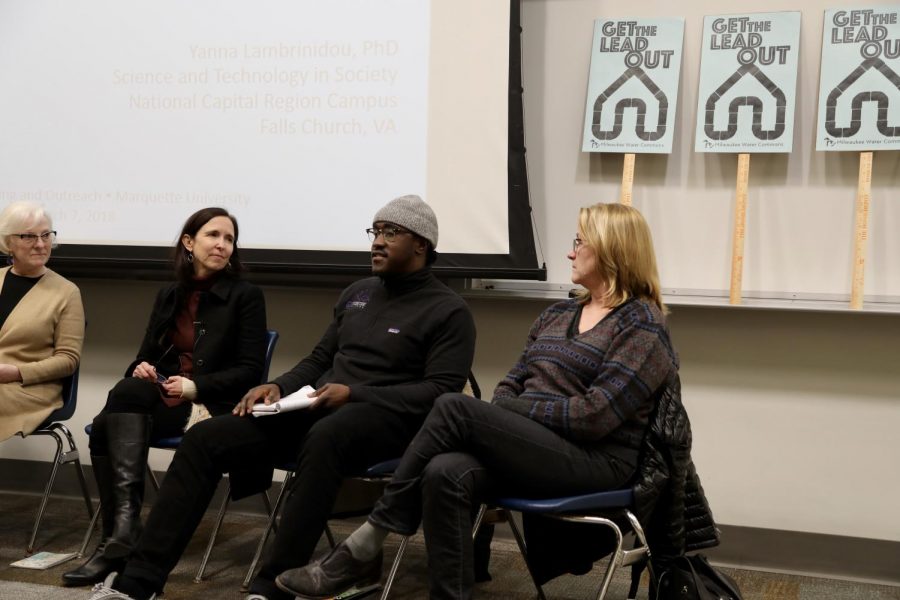A panel of community activists and experts discussed the prevalence of lead pipes in Milwaukee at an event hosted by the Center for Urban Research Teaching and Outreach in Marquette Hall at 7 p.m. March 7.
The six-person panel was led by input from Yanna Lambrinidou, an expert on lead water pipes and faculty member at Virginia Tech. She became interested in the issue following the discovery of Washington D.C.’s lead water contamination in 2004.
“Lead in drinking water is a problem that we all have in every single home. There are no exceptions at all,” Lambrinidou said. “And that’s because lead exists in all of our plumbing. Whether we have lead laterals or not, there are so many other components that have lead in them.”
Lead laterals are water pipes made entirely of lead, she said. Homes without lead laterals can still have plumbing systems with lead-based pieces.
“Lead service lines function really as lead straws. We’re drinking and eating our food through lead straws,” Lambrinidou said. “What that does, especially to developing brains, is that it causes permanent brain damage and all sorts of problems that go with that.”
Sam Harshner, an adjunct instructor in political science and organizer of the event, said lead laterals affect people throughout the city.
“The potential that Marquette students – especially those in off-campus housing – have lead pipes feeding their water supply is very distinctly possible. That’s something that could be happening,” he said. “It’s something that we should all be caring about.”
Lambrinidou said lead pipes have historically been used due to their malleability and durability.
“Lead continues to be added to brand new fixtures today because it’s a malleable metal that makes plumbing easier,” she said.
The effects on children and women of reproductive age can be especially devastating, Lambrinidou said.
“When it comes to drinking water, unlike with lead in paint or lead in gasoline, drinking water is something that pregnant women need for their fetuses to grow,” she said. “We are exposing children routinely and throughout the country to this.”
While some consumed lead flushes out of the body, Lambrinidou said some remains stored in teeth and bones.
“When children have been exposed to lead and then the lead is stored in bones and teeth, that lead can come back out again during times of pregnancy or other times when bodies go through transitions,” she said.
Lambrinidou said solutions to lead water pipes must encompass all community members.
“People who know about it are able to take measures to protect themselves. People are able to install filters for themselves, turn to alternative sources of water,” she said. “People who do not know about this or cannot afford alternatives are stuck with whatever comes out of the tap.”
She said poorer communities who are unable to afford solutions may continue living in risk of lead contamination, while more affluent communities can quickly take measures to protect themselves.
“Sometimes these solutions perpetuate injustice because sometimes the solutions are created in such a way where folks who can afford them can go for them,” Lambrinidou said.
Kirsten Shead, a panelist from the Milwaukee Water Commons, echoed a similar thought.
“Especially in a city like Milwaukee, where there’s such segregation and such historical marginalization of people, I think about what (I would do if) I couldn’t afford that $30 filter,” Shead said.
Misleading messages and false assurances from authority figures have allowed lead pipes to continue existing in homes, Lambrinidou said.
“We are facing a culture of disinformation about this issue that comes from above and that comes from the authorities that we have been conditioned all our lives to trust,” Lambrinidou said. “These are our physicians, our pediatricians, our water utility managers, our politicians (and) the environmental protection agencies.”
The ways water is tested for lead contamination must also be reconsidered, she said. Even if a tap is tested ten times and no lead is found, the eleventh test could contain an astronomical amount of lead.
Lambrinidou said current federal tests sample a tap once, which could miss the possibility of a high lead level in subsequent samples.
She said lead can exist in water in soluble forms — such as dissolved sugar — or as lead particles, which can fall into the water due to disturbance from high water pressure, warm weather or a variety of other factors.
Sherrie Tussler was a panelist representing Hunger Task Force who experienced lead poisoning herself. She works to provide children with nutrients to combat the effects of lead.
“A diet high in three key nutrients — Vitamin C, Iron and Calcium — can help mitigate lead absorption,” she said. “Hungry kids absorb lead five times faster than well-fed kids.”
Lambrinidou said Milwaukee is currently at the forefront of this issue nationally.
“Milwaukee is unique in that there wasn’t a major catastrophe that triggered us to move. There wasn’t a Flint episode, there wasn’t a DC-kind of episode,” Robert Miranda, a panelist from Freshwater for Life Action Coalition, said. “It was a community movement that said, ‘Wait a minute. I don’t like the idea of us drinking water through lead straws. Why aren’t we doing something about this?’”
Shead said it is possible to find a feasible solution to counter the harmful effects of lead consumption from water pipes.
“We’ve dealt with complicated, expensive problems before and we’re going to do it (again),” she said.
Lambrinidou said government officials, not homeowners, are responsible for the replacement of dangerous lead service lines. The Milwaukee water department mandated the use of lead service lines in 1872 and should address the issue in a modern-day context, she said.
Community activism has pressured politicians to start acting on this issue, Miranda said. Moving forward, he said discussion with elected officials should be guided by community concerns.
“I believe that the current elected officials have known this matter for decades. They’ve known what’s been going on in our community. They’ve known what’s been going on with this water,” Miranda said. “If there is an invitation to the table, it would be on the community’s terms.”




Richard Rabin • Jun 1, 2018 at 1:31 pm
There is another culprit in the story of lead in our water: the lead industry. For decades after the lead companies – including NL Industries, ASARCO and Eagle Picher – knew that lead pipes could cause lead poisoning they continued to sell and promote lead pipes. (see The Lead Industry and Lead Water Pipes: “A Modest Campaign”; Am J Public Health. 2008;98:1584–1592) http://www.ncbi.nlm.nih.gov/pmc/articles/PMC2509614/